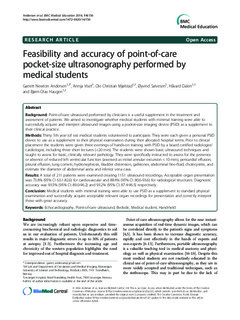| dc.contributor.author | Andersen, Garrett Newton | |
| dc.contributor.author | Viset, Annja Torlaug | |
| dc.contributor.author | Mjølstad, Ole Christian | |
| dc.contributor.author | Salvesen, Øyvind | |
| dc.contributor.author | Dalen, Håvard | |
| dc.contributor.author | Haugen, Bjørn Olav | |
| dc.date.accessioned | 2018-01-02T12:52:45Z | |
| dc.date.available | 2018-01-02T12:52:45Z | |
| dc.date.created | 2014-10-29T14:03:39Z | |
| dc.date.issued | 2014 | |
| dc.identifier.issn | 1472-6920 | |
| dc.identifier.uri | http://hdl.handle.net/11250/2474050 | |
| dc.description.abstract | Background
Point-of-care ultrasound performed by clinicians is a useful supplement in the treatment and assessment of patients. We aimed to investigate whether medical students with minimal training were able to successfully acquire and interpret ultrasound images using a pocket-size imaging device (PSID) as a supplement to their clinical practice.
Methods
Thirty 5th year (of six) medical students volunteered to participate. They were each given a personal PSID device to use as a supplement to their physical examination during their allocated hospital terms. Prior to clinical placement the students were given three evenings of hands-on training with PSID by a board certified radiologist/cardiologist, including three short lectures (<20 min). The students were shown basic ultrasound techniques and taught to assess for basic, clinically relevant pathology. They were specifically instructed to assess for the presence or absence of reduced left ventricular function (assessed as mitral annular excursion < 10 mm), pericardial effusion, pleural effusion, lung comets, hydronephrosis, bladder distension, gallstones, abdominal free-fluid, cholecystitis, and estimate the diameter of abdominal aorta and inferior vena cava.
Results
A total of 211 patients were examined creating 1151 ultrasound recordings. Acceptable organ presentation was 73.8% (95% CI 63.1-82.6) for cardiovascular and 88.4% (95% CI: 80.6-93.6) for radiological structures. Diagnostic accuracy was 93.5% (95% CI: 89.0-96.2) and 93.2% (95% CI: 87.4-96.5) respectively.
Conclusion
Medical students with minimal training were able to use PSID as a supplement to standard physical examination and successfully acquire acceptable relevant organ recordings for presentation and correctly interpret these with great accuracy. | nb_NO |
| dc.language.iso | eng | nb_NO |
| dc.publisher | BioMed Central | nb_NO |
| dc.rights | Navngivelse 4.0 Internasjonal | * |
| dc.rights.uri | http://creativecommons.org/licenses/by/4.0/deed.no | * |
| dc.title | Feasibility and accuracy of point-of-care pocket-size ultrasonography performed by medical students | nb_NO |
| dc.type | Journal article | nb_NO |
| dc.type | Peer reviewed | nb_NO |
| dc.description.version | publishedVersion | nb_NO |
| dc.source.volume | 14 | nb_NO |
| dc.source.journal | BMC Medical Education | nb_NO |
| dc.source.issue | 1 | nb_NO |
| dc.identifier.doi | 10.1186/1472-6920-14-156 | |
| dc.identifier.cristin | 1168082 | |
| dc.relation.project | Norges forskningsråd: 219282 | nb_NO |
| dc.description.localcode | © Andersen et al.; licensee BioMed Central Ltd. 2014 This article is published under license to BioMed Central Ltd. This is an Open Access article distributed under the terms of the Creative Commons Attribution License (http://creativecommons.org/licenses/by/2.0) | nb_NO |
| cristin.unitcode | 194,65,25,0 | |
| cristin.unitcode | 194,65,15,0 | |
| cristin.unitname | Institutt for sirkulasjon og bildediagnostikk | |
| cristin.unitname | Institutt for klinisk og molekylær medisin | |
| cristin.ispublished | true | |
| cristin.fulltext | original | |
| cristin.qualitycode | 1 | |

